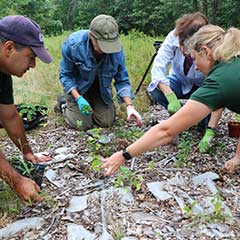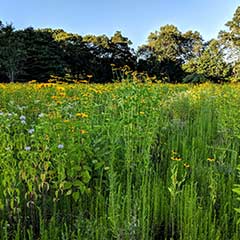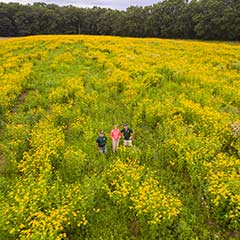We're reintroducing New England blazing stars and other rare dry soil wildflowers on conservation land around Middlesex County. These plants help remove and retain carbon from the atmosphere, require little or no continued maintenance, and provide habitat to dozens of species of native animals, particularly to insect pollinators. Working with local towns, we plant seedlings grown by local volunteers. To date, we've planted vital pollinator species in eight locations: the Arnold Arboretum and Victory Gardens in Boston, Joyce Miller's Meadow and Whipple Hill in Lexington, Foss Farm in Carlisle; Heywood Meadow and Peter Spring Field in Concord, and Town Forest in Dunstable.
With nearly five acres blooming with wildflowers native to Massachusetts and the northeastern U.S., Peter Spring Field is our biggest pollinator accomplishment so far. This field is likely one of the largest concentrations of native wildflowers in Massachusetts. Among the more widespread flower species are: oxeye sunflower, lance-leaved coreopsis, wild bergamot, showy tick trefoil, tall evening primrose, common milkweed, partridge pea, black-eyed susan, daisy fleabane, and rattlebox. We recorded a substantial population of a small moth species, the ornate bella moth (Utetheisa ornatrix), whose larvae depend on the relatively rare legume, rattlebox. This moth had been regarded previously as extirpated from Massachusetts. We also observed the first blooming of the rare native butterfly milkweed (Asclepias tuberosa). In warm weather the field is abuzz with bees, birds, dragonflies and beetles, and serves as an ideal turtle nesting habitat. In fact, this area of the field has been reserved, through the town's lease, for nesting by the Threatened Blanding's turtle.
The Value of Native Wildflowers
New England blazing star is a native wildflower in the aster family that used to be widespread across Massachusetts. This plant has all but disappeared from northeastern Massachusetts and is now listed under the Massachusetts Endangered Species Act as a species of Special Concern.
Wildflowers like the New England blazing star provide vital forage to our native pollinators, such as bees, wasps, moths and butterflies. Blazing stars, in particular, are critical nectar plants that monarch butterflies depend upon to fuel their autumn migration to Mexico.
Many native pollinator species are on the decline due to habitat loss. By planting native wildflowers in your backyard, you can help provide habitat for both declining native wildflowers and their insect pollinators. We encourage you to check out the Xerces Society for ideas on what native plants you can plant in your backyard to help pollinators in your area!
New England Blazing Star Fact Sheet





